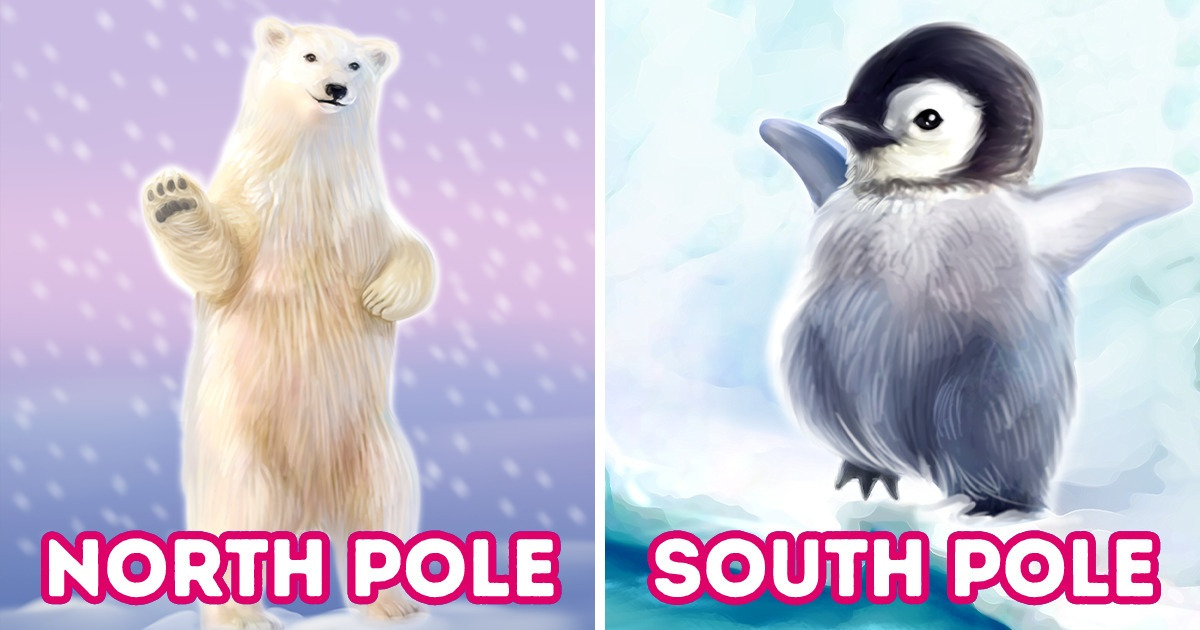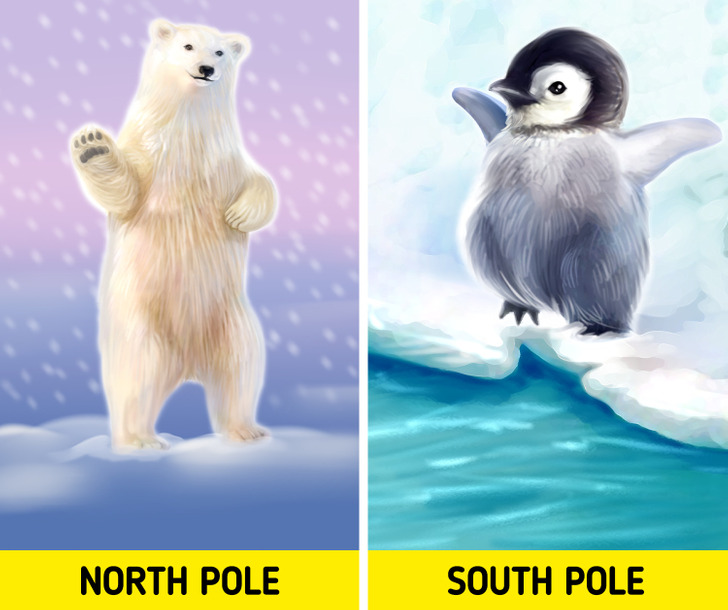Differences Between the North Pole and the South Pole

The North Pole and South Pole are the northernmost and southernmost points of the Earth, respectively. The North Pole is located in the center of the region called the Arctic, and the South Pole is in the center of the continent Antarctica.
5-Minute Crafts would like to tell you about the North Pole and South Pole and how they are different from each other.
North Pole
The North Pole is the point in the Northern Hemisphere where the Earth’s axis of rotation meets the surface. It’s located in the middle of the Arctic Ocean and is surrounded by water that is almost permanently covered with ice. The distance to the nearest landmass, which is the northern border of Greenland, is approximately 450 miles.
Nowadays, no country owns the North Pole or the surrounding area of the Arctic Ocean according to international law. However, the North Pole is at the center of a region called the Arctic, and the surrounding areas and landmasses are inhabited by indigenous peoples. They make up about 4 million people. In addition, the Arctic has rich wildlife, including polar bears, reindeer, arctic foxes, hares, squirrels, ringed seals, and some bird species.
The North Pole is the northernmost point on Earth. The temperature here ranges from 55°F in the summer to −67°F in the winter. The sun at the North Pole is always above the horizon during the summer and below the horizon during the winter, meaning it rises and sets only once a year. Sunrise begins shortly before the March equinox, and sunset ends just after the September equinox.
The geographic coordinates of the North Pole are at 90° north latitude. This is the point that defines the direction of true north. At the same time, all directions point to the south at the North Pole. Also at the North Pole, all lines of longitude converge, as well as all time zones. However, due to the fact that people are not constantly present at the North Pole, no specific time zone has been assigned to it.
South Pole
The South Pole is the point in the Southern Hemisphere where the Earth’s axis of rotation meets the surface. It’s located in the center of the continent of Antarctica and is surrounded by land. The distance to the nearest sea, the Bay of Whales, is approximately 800 miles.
Currently, under international law, no country owns the South Pole, in particular, or the continent of Antarctica as a whole. In addition, unlike the Arctic, there are no indigenous people living on the mainland. Only the personnel of scientific stations come here. The wildlife in Antarctica are mainly represented by seals, elephant seals, penguins, and many other bird species.
The South Pole is the southernmost point on the planet, which is located on the opposite side of the Earth from the North Pole at a distance of 12,430 miles in all directions. Temperatures range from 9.86°F during the summer to −79.6°F during the winter. The sun at the South Pole is constantly above the horizon during the southern winter and below the horizon during the southern summer. This means it rises and sets only once a year just like at the North Pole. Sunrise begins just after the September equinox, and sunset ends shortly before the March equinox.
The geographical coordinates of the South Pole are at 90° south latitude, this point defines the direction of true south. At the same time, all directions point to the north at the South Pole. All lines of longitude and all time zones converge here just like at the North Pole. Due to the fact that people are rarely present here, no specific time zone has been assigned to the South Pole, but for practical convenience, the Amundsen—Scott South Pole Station keeps New Zealand Time. This is because the station gets its supplies from this country.
Key differences between the North Pole and the South Pole

5 key differences between the poles of our planet:
- The North Pole is at the center of the ocean, which is surrounded by land. The South Pole is at the center of a continent, which is surrounded by water.
- The sun can be seen from March to September at the North Pole, and from September to March at the South Pole.
- Due to the effect of the ocean, the climate at the North Pole is milder than at the South Pole. In summer, the air can warm up to 55°F, while at the opposite point on Earth the temperature always remains below 32°F.
- About 4 million indigenous people live in the Arctic region, which surrounds the North Pole. And at the South Pole and in Antarctica, you will only encounter research station personnel.
- Polar bears live at the North Pole, and penguins live at the South Pole. Their paths never cross in wild nature.